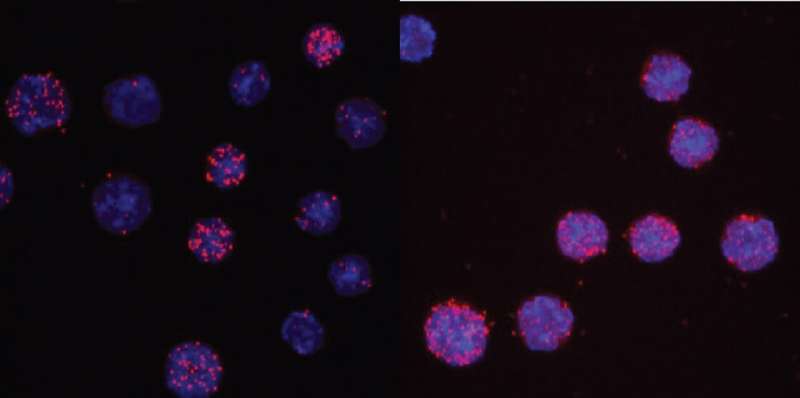This article has been reviewed according to Science X's editorial process and policies. Editors have highlighted the following attributes while ensuring the content's credibility:
fact-checked
peer-reviewed publication
proofread
Researchers reveal how cells rewrite their fate

Researchers at the Centre for Genomic Regulation (CRG) in Barcelona and the Max Delbrück Center for Molecular Medicine in the Helmholtz Association in Berlin have revealed how cells accelerate changes to their identity, a process known as cell fate conversion.
The study, published today in the journal eLife, has implications for cancer research as the disease often arises from errors in cell fate decisions. The study could eventually lead to new methods of accelerating or manipulating the molecular mechanisms involved in the formation of cancer.
Central to the study is C/EBPα (CCAAT/enhancer-binding protein alpha), a protein that orchestrates the conversion of B lymphocytes to macrophages, another type of immune cell. C/EBPα is a transcription factor, a type of protein which binds to specific DNA sequences in the regulatory regions of genes to influence the rate of transcription, the first step that leads to the activation or silencing of protein expression. Transcription factors play a vital role in the transformation of one cell type to another during differentiation and development, as well as in the growth and function of cells.
Like many other proteins, C/EBPα is modified by enzymes, for example through the addition of a methyl group to specific amino acids. These modifications can have significant effects on interactions of the protein. The researchers found that when one specific arginine residue of C/EBPα is left unmethylated, it greatly accelerates the conversion process of B lymphocytes to macrophages.
The study also found that the methylation of this specific arginine residue is mediated by the enzyme Carm1. Previous research has shown that Carm1-deficient mice are resistant to induced forms of acute myeloid leukemia. The researchers hypothesize that the mechanisms they uncover in the present study can explain why: the unmethylated version of C/EBPα is a stronger inducer of macrophage differentiation compared to its methylated counterpart. As macrophages are a non-dividing cell type, this could prevent the formation of cancer cells.
Dr. Thomas Graf, senior author from the Centre for Genomic Regulation, says, "By understanding how cell fate conversion can be accelerated or directed, we uncover new clues for cancer research. For example, targeting the balance between methylated and unmethylated forms of C/EBPα can help us understand how immune cells differentiate and eventually lead to new ideas for treating certain forms of leukemia."
The researchers made the discovery while screening for C/EBPα mutants which affect the efficiency of cell fate conversion using human and mouse models. The location of the critical amino acid within C/EBPα was found when the authors tested a mutant form called C/EBPαR35A. This mutant dramatically accelerated the speed by which B cells could be turned into macrophages.
To induce a cell conversion, C/EBPα works by interacting with another transcription factor called PU.1, which itself is essential for the development of immune cells and is already expressed in B cells. C/EBPαR35A had a much higher interaction affinity with PU.1, increasing the speed by which the combination of the two proteins silence the genes associated with B cells and activate the genes associated with macrophages.
The methylation of C/EBPα is an example of an epigenetic mechanism. These are mechanisms which modify how the genome—the instruction manual inside every cell of the human body—is read. "Drugs that affect epigenetic mechanisms as described in the present study may indeed alter the function of transcription factors and correct cells that went astray, such as seen in cancer and leukemia," says Dr. Achim Leutz, senior author from the Max-Delbrück-Center.
"In this novel mechanism PU.1 is triggered by C/EBPα to switch from a B cell regulator into a macrophage regulator, an elegant 'on-off' mechanism that ensures the faithful formation of a mature cell type, avoiding the formation of 'confused' cells often seen in blood cancers. Therefore, drugs might be found that target this mechanism to correct such defects," adds Dr. Leutz.
According to the authors of the study, much remains unknown about what determines the speed and directionality of cell fate decisions and their new work suggests that the two processes are two sides of the same coin. For instance, how do stem cells sequentially transform into the many different types of cells in the body? Better understanding how cells change their identity and how to manipulate the process might have applications from regenerative medicine to improving the efficacy of drugs against cancer.
The research was led by a joint collaboration between the Centre for Genomic Regulation in Barcelona, the Max Delbrück Center for Molecular Medicine in Berlin and the University of Pennsylvania in Philadelphia.
More information: Guillem Torcal Garcia et al, Carm1-arginine methylation of the transcription factor C/EBPα regulates transdifferentiation velocity, eLife (2023). DOI: 10.7554/eLife.83951
Journal information: eLife
Provided by Center for Genomic Regulation



















